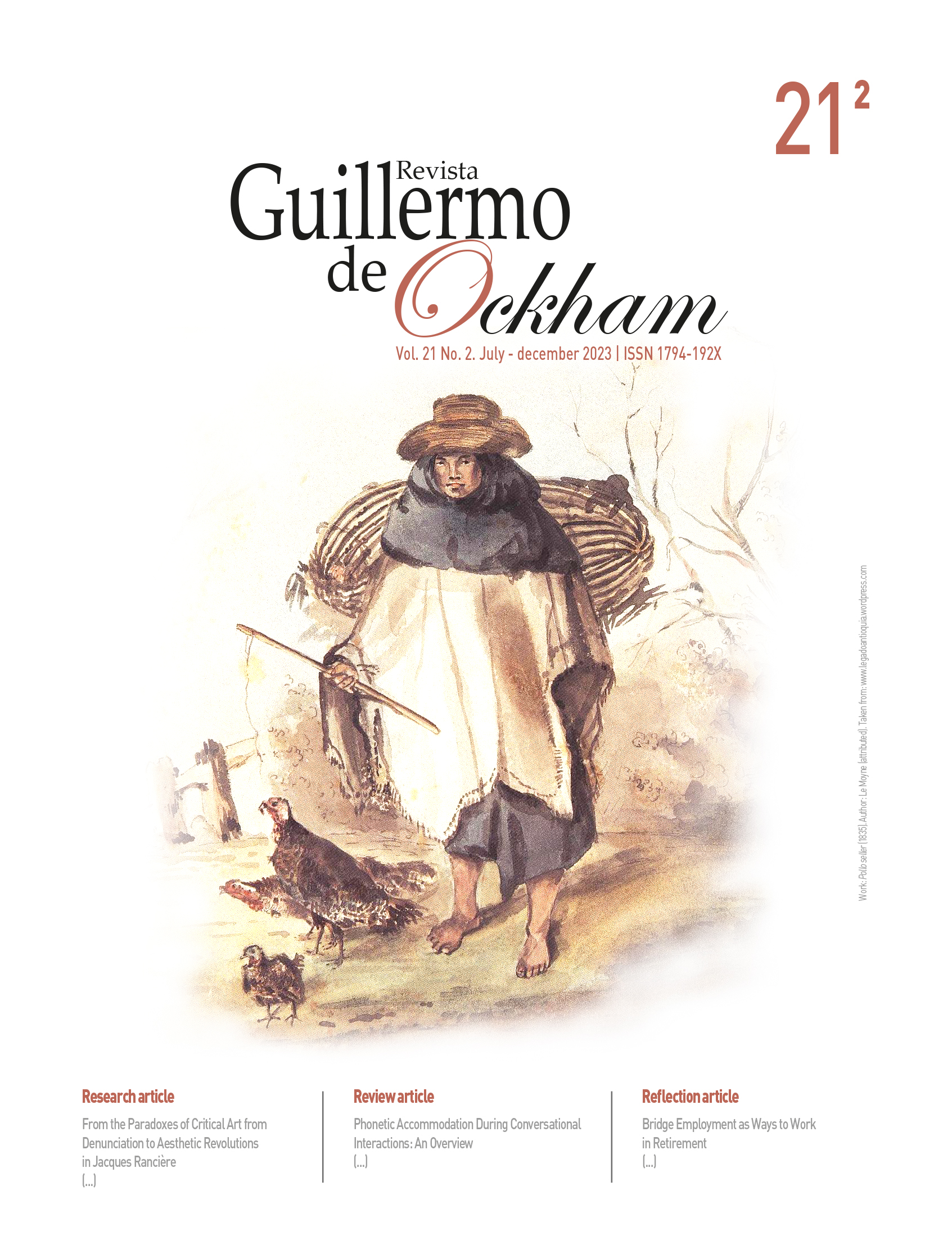The Revista Guillermo de Ockham provides an immediate and open access to its content, based on the principle of offering the public a free access to investigations to provide a global interchange of knowledge.
Unless otherwise established, the contents of this journal has a license with Creative Commons Attribution-NonCommercial-NoDerivatives 4.0 International (CC BY-NC-ND 4.0) http://creativecommons.org/licenses/by-nc-nd/4.0/
- Attribution: You must give appropriate credit, provide a link to the license, and indicate if changes were made. You may do so in any reasonable manner, but not in any way that suggests the licensor endorses you or your use.
- NonCommercial: You may not use the material for commercial purposes.
- NoDerivatives: If you remix, transform, or build upon the material, you may not distribute the modified material.
- No additional restrictions: You may not apply legal terms or technological measures that legally restrict others from doing anything the license permits.
Abstract
During conversational interactions such as tutoring, instruction-giving tasks, verbal negotiations, or just talking with friends, interlocutors’ behaviors experience a series of changes due to the characteristics of their counterpart and to the interaction itself. These changes are pervasively present in every social interaction, and most of them occur in the sounds and rhythms of our speech, which is known as acoustic-prosodic accommodation, or simply phonetic accommodation. The consequences, linguistic and social constraints, and underlying cognitive mechanisms of phonetic accommodation have been studied for at least 50 years, due to the importance of the phenomenon to several disciplines such as linguistics, psychology, and sociology. Based on the analysis and synthesis of the existing empirical research literature, in this paper we present a structured and comprehensive review of the qualities, functions, onto- and phylogenetic development, and modalities of phonetic accommodation.
Keywords:
References
Arriaga, G., Zhou, E. P., & Jarvis, E. D. (2012). Of mice, birds, and men: The mouse ultrasonic song system has some features similar to humans and song-learning birds. PLoS ONE, 7(10), e46610. https://doi.org/10.1371/journal.pone.0046610
Aubanel, V., & Nguyen, N. (2010). Automatic recognition of regional phonological variation in conversational interaction. Speech Communication, 52(6), 577-586. https://doi.org/10.1016/j.specom.2010.02.008
Babel, M. (2010). Dialect divergence and convergence in New Zealand English. Language in Society, 39(4), 437-456. https://doi.org/10.1017/s0047404510000400
Babel, M. (2011). Imitation in speech. Acoustics Today, 7(4), 16-22. https://doi.org/10.1121/1.3684224
Babel, M. (2012). Evidence for phonetic and social selectivity in spontaneous phonetic imitation. Journal of Phonetics, 40(1), 177-189. https://doi.org/10.1016/j.wocn.2011.09.001
Babel, M., & Bulatov, D. (2011). The role of fundamental frequency in phonetic accommodation. Language and Speech, 55(2), 231-248. https://doi.org/10.1177/0023830911417695
Barón-Birchenall, L. (2016). Animal communication and human language: An overview. International Journal of Comparative Psychology, 29, 1-27. https://doi.org/10.46867/ijcp.2016.29.00.07
Barón-Birchenall, L. (2018). Influence of sentence-level rhythmic regularity and phonological phrasing on linguistic accommodation during conversational interactions: The case of Spanish-speaking dyads [Doctoral dissertation, Aix Marseille Université]. HAL. https://hal.archives-ouvertes.fr/tel-01993542
Barón-Birchenall, L. (2022). Sentence-level rhythmic regularity and accentual-group phrasing increase linguistic resemblance between Spanish-speaking interlocutors. Manuscript submitted for publication.
Beebe, B., Sorter, D., Rustin, J., & Knoblauch, S. (2003). A comparison of Meltzoff, Trevarthen, and Stern. Psychoanalytic Dialogues, 13(6), 777-804. https://doi.org/10.1080/10481881309348768
Bell, L., Gustafson, J., & Heldner, M. (2003). Prosodic adaptation in human-computer interaction [Conference presentation]. 15th International Congress of Phonetic Sciences, Barcelona, Spain. http://www.internationalphoneticassociation.org/icphs-proceedings/ICPhS2003/papers/p15_2453.pdf
Bloom, K. (1998). The missing link’s missing link: Syllabic vocalizations at 3 months of age. Behavioral and Brain Sciences, 21(4), 514-515. https://doi.org/10.1017/s0140525x98251260
Bonin, F., De Looze, C., Ghosh, S., Gilmartin, E., Vogel, C., Polychroniou, A., Salamin, H., Vinciarelli, A., & Campbell, N. (2013). Investigating fine temporal dynamics of prosodic and lexical accommodation. In Proceedings of Interspeech 2013 (pp. 539-543). ISCA. https://eprints.gla.ac.uk/93668/1/93668.pdf
Borrie, S. A., & Liss, J. M. (2014). Rhythm as a coordinating device: Entrainment with disordered speech. Journal of Speech, Language, and Hearing Research, 57(3), 815-824. https://doi.org/10.1044/2014_jslhr-s-13-0149
Borrie, S. A., Lubold, N., & Pon-Barry, H. (2015). Disordered speech disrupts conversational entrainment: A study of acoustic-prosodic entrainment and communicative success in populations with communication challenges. Frontiers in Psychology, 6, 1187. https://doi.org/10.3389/fpsyg.2015.01187
Casasanto, L. S., Jasmin, K., & Casasanto, D. (2010). Virtually accommodating: Speech rate accommodation to a virtual interlocutor [Conference presentation]. 32nd Annual Meeting of the Cognitive Science Society, Austin, United States. https://pure.mpg.de/rest/items/item_458220/component/file_529234/content
Chartrand, T. L., & Bargh, J. A. (1999). The chameleon effect: The perception–behavior link and social interaction. Journal of Personality and Social Psychology, 76(6), 893-910. https://doi.org/10.1037/0022-3514.76.6.893
Clopper, C. G., & Dossey, E. (2020). Phonetic convergence to Southern American English: Acoustics and perception. The Journal of the Acoustical Society of America, 147(1), 671-683. https://doi.org/10.1121/10.0000555
Cohen, U., Edelist, L., & Gleason, E. (2017). Converging to the baseline: Corpus evidence for convergence in speech rate to interlocutor’s baseline. The Journal of the Acoustical Society of America, 141(5), 2989-2996. https://doi.org/10.1121/1.4982199
Collins, B. (1998). Convergence of fundamental frequencies in conversation: If it happens, does it matter? [Conference presentation]. 5th International Conference on Spoken Language Processing, Sydney, Australia. https://doi.org/10.21437/icslp.1998-111
Condon, W. S., & Sander, L. W. (1974). Synchrony demonstrated between movements of the neonate and adult speech. Child Development, 45(2), 456-462. https://doi.org/10.2307/1127968
Coulston, R., Oviatt, S., & Darves, C. (2002). Amplitude convergence in children’s conversational speech with animated personas [Conference presentation]. 7th International Conference on Spoken Language Processing, Denver, United States. https://doi.org/10.21437/icslp.2002-671
De Looze, C., & Rauzy, S. (2011). Measuring speakers’ similarity in speech by means of prosodic cues: Methods and potential. In Proceedings of Interspeech 2011 (pp. 1393-1396). ISCA. https://doi.org/10.21437/interspeech.2011-457
De Looze, C., Oertel, C., Rauzy, S., & Campbell, N. (2011). Measuring dynamics of mimicry by means of prosodic cues in conversational speech [Conference presentation]. 17th International Congress of Phonetic Sciences, Hong Kong. https://hal.archives-ouvertes.fr/hal-01705525/document
De Looze, C., Scherer, S., Vaughan, B., & Campbell, N. (2014). Investigating automatic measurements of prosodic accommodation and its dynamics in social interaction. Speech Communication, 58, 11-34. https://doi.org/10.1016/j.specom.2013.10.002
Delaherche, E., Chetouani, M., Mahdhaoui, A., Saint-Georges, C., Viaux, S., & Cohen, D. (2012). Interpersonal synchrony: A survey of evaluation methods across disciplines. EEE Transactions on Affective Computing, 3(3), 349-365. https://doi.org/10.1109/T-AFFC.2012.12
Delvaux, V., & Soquet, A. (2007). The influence of ambient speech on adult speech productions through unintentional imitation. Phonetica, 64(2-3), 145-173. https://doi.org/10.1159/000107914
Doupe, A. J., & Kuhl, P. K. (1999). Birdsong and human speech: Common themes and mechanisms. Annual Review of Neuroscience, 22, 567-631. https://doi.org/10.1146/annurev.neuro.22.1.567
Duran, N. D., & Fusaroli, R. (2017). Conversing with a devil’s advocate: Interpersonal coordination in deception and disagreement. PLoS ONE, 12(6), e0178140. https://doi.org/10.1371/journal.pone.0178140
Duranton, C., & Gaunet, F. (2016). Behavioural synchronization from an ethological perspective: Overview of its adaptive value. Adaptive Behavior, 24(3), 181-191. https://doi.org/10.1177/1059712316644966
Edlund, J., Heldner, M., & Hirschberg, J. (2009). Pause and gap length in face-to-face interaction. In Proceedings of Interspeech 2009 (pp. 2779-2782). ISCA. https://doi.org/10.21437/interspeech.2009-710
Evans, B. G., & Iverson, P. (2007). Plasticity in vowel perception and production: A study of accent change in young adults. The Journal of the Acoustical Society of America, 121(6), 3814-3826. https://doi.org/10.1121/1.2722209
Fehér, O., Ritt, N., & Smith, K. (2019). Asymmetric accommodation during interaction leads to the regularisation of linguistic variants. Journal of Memory and Language, 109, 104036. https://doi.org/10.1016/j.jml.2019.104036
Feldman, R., Mayes, L. C., & Swain, J. E. (2005). Interaction synchrony and neural circuits contribute to shared intentionality. Behavioral and Brain Sciences, 28(5), 697-698. https://doi.org/10.1017/s0140525x0529012x
Fitch, W. T. (2010). The evolution of language. Cambridge University Press. https://doi.org/10.1017/CBO9780511817779
Freud, D., Ezrati-Vinacour, R., & Amir, O. (2018). Speech rate adjustment of adults during conversation. Journal of Fluency Disorders, 57, 1-10. https://doi.org/10.1016/j.jfludis.2018.06.002
Fusaroli, R., Rączaszek-Leonardi, J., & Tylén, K. (2014). Dialog as interpersonal synergy. New Ideas in Psychology, 32, 147-157. https://doi.org/10.1016/j.newideapsych.2013.03.005
Garrod, S., & Pickering, M. J. (2004). Why is conversation so easy? Trends in Cognitive Sciences, 8(1), 8-11. https://doi.org/10.1016/j.tics.2003.10.016
Gentilucci, M., & Bernardis, P. (2007). Imitation during phoneme production. Neuropsychologia, 45(3), 608-615. https://doi.org/10.1016/j.neuropsychologia.2006.04.004
Gessinger, I., Schweitzer, A., Andreeva, B., Raveh, E., Möbius, B., & Steiner, I. (2018). Convergence of pitch accents in a shadowing task. In 9th International Conference on Speech Prosody 2018 (pp. 225-229). ISCA. https://doi.org/10.21437/speechprosody.2018-46
Giles, H., Coupland, N., & Coupland, J. (1991). Accommodation theory: Communication, context, and consequence. In H. Giles, J. Coupland & N. Coupland (Eds.), Contexts of accommodation: Developments in applied sociolinguistics (pp. 1-68). Cambridge University Press. https://doi.org/10.1017/cbo9780511663673.001
Goldinger, S. D. (1998). Echoes of echoes? An episodic theory of lexical access. Psychological Review, 105(2), 251-279. https://doi.org/10.1037/0033-295x.105.2.251
Goldinger, S. D., & Azuma, T. (2004). Episodic memory reflected in printed word naming. Psychonomic Bulletin & Review, 11(4), 716-722. https://doi.org/10.3758/bf03196625
Gregory, S. W., & Hoyt, B. R. (1982). Conversation partner mutual adaptation as demonstrated by Fourier series analysis. Journal of Psycholinguistic Research, 11(1), 35-46. https://doi.org/10.1007/bf01067500
Gregory, S. W., & Webster, S. (1996). A nonverbal signal in voices of interview partners effectively predicts communication accommodation and social status perceptions. Journal of Personality and Social Psychology, 70(6), 1231-1240. https://doi.org/10.1037/0022-3514.70.6.1231
Gregory, S. W., Webster, S., & Huang, G. (1993). Voice pitch and amplitude convergence as a metric of quality in dyadic interviews. Language & Communication, 13(3), 195-217. https://doi.org/10.1016/0271-5309(93)90026-j
Hay, J., Jannedy, S., & Mendoza-Denton, N. (1999). Oprah and /ay/: Lexical frequency, referee design and style [Conference presentation]. 14th International Congress of Phonetic Sciences, Berkeley, United States. http://www.internationalphoneticassociation.org/icphs-proceedings/ICPhS1999/papers/p14_1389.pdf
Heath, J. (2014). Accommodation can lead to innovated variation. University of California, Berkeley Phonology Lab Annual Report, 10, 119-145. https://doi.org/10.5070/p78f86j4k3
Heath, J. (2015). Convergence through divergence: Compensatory changes in phonetic accommodation. LSA 2015 Annual Meeting Extended Abstracts, 6, 1-4. http://journals.linguisticsociety.org/proceedings/index.php/ExtendedAbs/article/view/3002
Heldner, M., Edlund, J., & Hirschberg, J. (2010). Pitch similarity in the vicinity of backchannels. In Proceedings of Interspeech 2010 (pp. 3054-3057). ISCA. https://doi.org/10.21437/interspeech.2010-58
Himberg, T., Hirvenkari, L., Mandel, A., & Hari, R. (2015). Word-by-word entrainment of speech rhythm during joint story building. Frontiers in Psychology, 6, 797. https://doi.org/10.3389/fpsyg.2015.00797
Kawasaki, M., Yamada, Y., Ushiku, Y., Miyauchi, E., & Yamaguchi, Y. (2013). Inter-brain synchronization during coordination of speech rhythm in human-to-human social interaction. Scientific Reports, 3, 1692. https://doi.org/10.1038/srep01692
Kim, M., Horton, W. S., & Bradlow, A. R. (2011). Phonetic convergence in spontaneous conversations as a function of interlocutor language distance. Laboratory Phonology, 2(1), 125-156. https://doi.org/10.1515/labphon.2011.004
King, S. L., Harley, H. E., & Janik, V. M. (2014). The role of signature whistle matching in bottlenose dolphins, Tursiops truncatus. Animal Behaviour, 96, 79-86. https://doi.org/10.1016/j.anbehav.2014.07.019
Koban, L., Ramamoorthy, A., & Konvalinka, I. (2017). Why do we fall into sync with others? Interpersonal synchronization and the brain’s optimization principle. Social Neuroscience, 14, 1-9. https://doi.org/10.1080/17470919.2017.1400463
Kousidis, S., Dorran, D., McDonnell, C., & Coyle, E. (2009). Convergence in human dialogues: Times series analysis of acoustic feature [Conference presentation]. SPECOM 2009, St. Petersburg, Russia. https://arrow.tudublin.ie/dmccon/2/
Kousidis, S., Dorran, D., Wang, Y., Vaughan, B., Cullen, C., Campbell, D., McDonnell, C., & Coyle, E. (2008). Towards measuring continuous acoustic feature convergence in unconstrained spoken dialogues. In Proceedings of Interspeech 2008 (pp. 22-26). ISCA. https://doi.org/10.21437/interspeech.2008-369
Lee, C. C., Black, M., Katsamanis, A., Lammert, A. C., Baucom, B. R., Christensen, A., Georgiou, P. G., & Narayanan, S. S. (2010). Quantification of prosodic entrainment in affective spontaneous spoken interactions of married couples. In Proceedings of Interspeech 2010 (pp. 793-796). ISCA. https://doi.org/10.21437/Interspeech.2010-287
Lee, Y., Danner, S. G., Parrell, B., Lee, S., Goldstein, L., & Byrd, D. (2018). Articulatory, acoustic, and prosodic accommodation in a cooperative maze navigation task. PLoS ONE, 13(8), e0201444. https://doi.org/10.1371/journal.pone.0201444
Lelong, A., & Bailly, G. (2011). Study of the phenomenon of phonetic convergence thanks to speech dominoes. In A. Esposito, A. Vinciarelli, K. Vicsi, C. Pelachaud & A. Nihjolt (Eds.), Analysis of verbal and nonverbal communication and enactment: The processing issue (pp. 273-285). Springer. https://doi.org/10.1007/978-3-642-25775-9_26
Levitan, R., Gravano, A., & Hirschberg, J. (2011). Entrainment in speech preceding backchannels. In Proceedings of the 49th Annual Meeting of the Association for Computational Linguistics. Association for Computational Linguistics. https://academiccommons.columbia.edu/doi/10.7916/D8DN4DFM/download
Levitan, R., Gravano, A., Wilson, L., Beňuš, Š., Hirschberg, J., & Nenkova, A. (2012). Acoustic-prosodic entrainment and social behavior [Conference presentation]. Conference of the North American Chapter of the Association for Computational Linguistics: Human Language Technologies, Montréal, Canada. https://aclanthology.org/N12-1002.pdf
Levitan, R., & Hirschberg, J. (2011). Measuring acoustic-prosodic entrainment with respect to multiple levels and dimensions. In Proceedings of Interspeech 2011 (pp. 3081-3084). ISCA. https://www.isca- speech.org/archive/interspeech_2011/levitan11_interspeech.html
Lewandowski, E. M., & Nygaard, L. C. (2018). Vocal alignment to native and non-native speakers of English. The Journal of the Acoustical Society of America, 144(2), 620-633. https://doi.org/10.1121/1.5038567
Lewandowski, N., & Jilka, M. (2019). Phonetic convergence, language talent, personality and attention. Frontiers in Communication, 4, 1-19. https://doi.org/10.3389/fcomm.2019.00018
Louwerse, M. M., Dale, R., Bard, E. G., & Jeuniaux, P. (2012). Behavior matching in multimodal communication is synchronized. Cognitive Science, 36(8), 1404-1426. https://doi.org/10.1111/j.1551-6709.2012.01269.x
Lubold, N., & Pon-Barry, H. (2014). A comparison of acoustic-prosodic entrainment in face-to-face and remote collaborative learning dialogues. In 2014 IEEE Spoken Language Technology Workshop (SLT) (pp. 288-293). IEEE. https://ieeexplore.ieee.org/document/7078589
MacNeilage, P. F. (1998). The frame/content theory of evolution of speech production. Behavioral and Brain Sciences, 21(4), 499-511. https://doi.org/10.1017/s0140525x98001265
Mampe, B., Friederici, A. D., Christophe, A., & Wermke, K. (2009). Newborns’ cry melody is shaped by their native language. Current Biology, 19(23), 1994-1997. https://doi.org/10.1016/j.cub.2009.09.064
Manson, J. H., Bryant, G. A., Gervais, M. M., & Kline, M. A. (2013). Convergence of speech rate in conversation predicts cooperation. Evolution and Human Behavior, 34(6), 419-426. https://doi.org/10.1016/j.evolhumbehav.2013.08.001
McGarva, A. R., & Warner, R. M. (2003). Attraction and social coordination: Mutual entrainment of vocal activity rhythms. Journal of Psycholinguistic Research, 32(3), 335-354. https://doi.org/10.1023/A:1023547703110
Merker, B. J., Madison, G. S., & Eckerdal, P. (2009). On the role and origin of isochrony in human rhythmic entrainment. Cortex, 45(1), 4-17. https://doi.org/10.1016/j.cortex.2008.06.011
Mitterer, H., & Ernestus, M. (2008). The link between speech perception and production is phonological and abstract: Evidence from the shadowing task. Cognition, 109(1), 168-173. https://doi.org/10.1016/j.cognition.2008.08.002
Mooney, S., & Sullivan, G. C. (2015). Investigating an acoustic measure of perceived isochrony in conversation: Preliminary notes on the role of rhythm in turn transitions. University of Pennsylvania Working Papers in Linguistics, 21(2), 128-135. https://repository.upenn.edu/pwpl/vol21/iss2/15
Muir, K., Joinson, A., Cotterill, R., & Dewdney, N. (2017). Linguistic style accommodation shapes impression formation and rapport in computer-mediated communication. Journal of Language and Social Psychology, 36(5), 525-548. https://doi.org/10.1177/0261927x17701327
Namy, L. L., Nygaard, L. C., & Sauerteig, D. (2002). Gender differences in vocal accommodation: The role of perception. Journal of Language and Social Psychology, 21(4), 422-432. https://doi.org/10.1177/026192702237958
Natale, M. (1975). Convergence of mean vocal intensity in dyadic communication as a function of social desirability. Journal of Personality and Social Psychology, 32(5), 790-804. https://doi.org/10.1037/0022-3514.32.5.790
Nguyen, N., & Delvaux, V. (2015). Role of imitation in the emergence of phonological systems. Journal of Phonetics, 53, 46-54. https://doi.org/10.1016/j.wocn.2015.08.004
Nielsen, K. (2011). Specificity and abstractness of VOT imitation. Journal of Phonetics, 39(2), 132-142. https://doi.org/10.1016/j.wocn.2010.12.007
Oben, B., & Brône, G. (2015). What you see is what you do: On the relationship between gaze and gesture in multimodal alignment. Language and Cognition, 7(4), 546-562. https://doi.org/10.1017/langcog.2015.22
Pardo, J. S. (2006). On phonetic convergence during conversational interaction. The Journal of the Acoustical Society of America, 119(4), 2382-2393. https://doi.org/10.1121/1.2178720
Pardo, J. S. (2013a). Reconciling diverse findings in studies of phonetic convergence. Proceedings of Meetings on Acoustics, 19(1), 060140. https://doi.org/10.1121/1.4798479
Pardo, J. S. (2013b). Measuring phonetic convergence in speech production. Frontiers in Psychology, 4, 559. https://doi.org/10.3389/fpsyg.2013.00559
Pardo, J. S., Gibbons, R., Suppes, A., & Krauss, R. M. (2012). Phonetic convergence in college roommates. Journal of Phonetics, 40(1), 190-197. https://doi.org/10.1016/j.wocn.2011.10.001
Pardo, J. S., Jay, I. C., & Krauss, R. M. (2010). Conversational role influences speech imitation. Attention, Perception, & Psychophysics, 72(8), 2254-2264. https://doi.org/10.3758/app.72.8.2254
Pardo, J. S., Jordan, K., Mallari, R., Scanlon, C., & Lewandowski, E. (2013). Phonetic convergence in shadowed speech: The relation between acoustic and perceptual measures. Journal of Memory and Language, 69(3), 183-195. https://doi.org/10.1016/j.jml.2013.06.002
Pickering, M. J., & Garrod, S. (2004). Toward a mechanistic psychology of dialogue. Behavioral and Brain Sciences, 27(2), 169-190. https://doi.org/10.1017/S0140525X04000056
Pickering, M. J., & Garrod, S. (2021). Understanding dialogue: Language use and social interaction. Cambridge University Press. https://doi.org/10.1017/9781108610728
Polyanskaya, L., Samuel, A. G., & Ordin, M. (2019). Speech rhythm convergence as a social coalition signal. Evolutionary Psychology, 17(3), 1-11. https://doi.org/10.1177/1474704919879335
Prat, Y., Taub, M., & Yovel, Y. (2015). Vocal learning in a social mammal: Demonstrated by isolation and playback experiments in bats. Science Advances, 1(2), e1500019. https://doi.org/10.1126/sciadv.1500019
Putman, W. B., & Street, R. L. (1984). The conception and perception of noncontent speech performance: Implications for speech-accommodation theory. International Journal of the Sociology of Language, 46, 97-114. https://doi.org/10.1515/ijsl.1984.46.97
Rao, G., & Smiljanic, R. (2011). Effects of language, speaking style and age on prosodic rhythm [Conference presentation]. 17th International Congress of Phonetic Sciences, Hong Kong. https://www.internationalphoneticassociation.org/icphs-proceedings/ICPhS2011/OnlineProceedings/RegularSession/Rao/Rao.pdf
Rao, G., Smiljanic, R., & Diehl, R. (2013). Individual variability in phonetic convergence of vowels and rhythm. Proceedings of Meetings on Acoustics, 19(1), 060084. https://doi.org/10.1121/1.4800750
Reitter, D., & Moore, J. (2007). Predicting success in dialogue [Conference presentation]. 45th Annual Meeting of the Association of Computational Linguistics, Prague, Czech Republic. https://era.ed.ac.uk/bitstream/handle/1842/4165/MooreJ_Predicting%20Success%20in%20Dialogue.pdf?sequence=1&isAllowed=y
Reverdy, J., Koutsombogera, M., & Vogel, C. (2020). Linguistic repetition in three-party conversations. In A. Esposito, M. Faundez-Zanuy, F. Morabito & E. Pasero (Eds.), Neural approaches to dynamics of signal exchanges (vol. 151, pp. 359-370). Springer. https://doi.org/10.1007/978-981-13-8950-4_32
Ruch, H., Zürcher, Y., & Burkart, J. M. (2017). The function and mechanism of vocal accommodation in humans and other primates. Biological Reviews, 93(2), 996-1013. https://doi.org/10.1111/brv.12382
Sanchez, K., Miller, R. M., & Rosenblum, L. D. (2010). Visual influences on alignment to voice onset time. Journal of Speech, Language, and Hearing Research, 53(2), 262-272. https://doi.org/10.1044/1092-4388(2009/08-0247)
Sancier, M. L., & Fowler, C. A. (1997). Gestural drift in a bilingual speaker of Brazilian Portuguese and English. Journal of Phonetics, 25(4), 421-436. https://doi.org/10.1006/jpho.1997.0051
Schoot, L., Heyselaar, E., Hagoort, P., & Segaert, K. (2016). Does syntactic alignment effectively influence how speakers are perceived by their conversation partner? PLoS ONE, 11(4), e0153521. https://doi.org/10.1371/journal.pone.0153521
Schultz, B. G., O’Brien, I., Phillips, N., McFarland, D. H., Titone, D., & Palmer, C. (2015). Speech rates converge in scripted turn-taking conversations. Applied Psycholinguistics, 37(5), 1201-1220. https://doi.org/10.1017/s0142716415000545
Schweitzer, A., & Lewandowski, N. (2013). Convergence of articulation rate in spontaneous speech. In Proceedings of Interspeech 2013 (pp. 525-529). ISCA. https://www.isca-speech.org/archive/interspeech_2013/schweitzer13_interspeech.html
Shockley, K., Sabadini, L., & Fowler, C. A. (2004). Imitation in shadowing words. Perception & Psychophysics, 66(3), 422-429. https://doi.org/10.3758/bf03194890
Späth, M., Aichert, I., Ceballos-Baumann, A. O., Wagner-Sonntag, E. W., Miller, N., & Ziegler, W. (2016). Entraining with another person’s speech rhythm: Evidence from healthy speakers and individuals with Parkinson’s disease. Clinical Linguistics and Phonetics, 30(1), 68-85. https://doi.org/10.3109/02699206.2015.1115129
Street, R. L. (1984). Speech convergence and speech evaluation in fact-finding interviews. Human Communication Research, 11(2), 139-169. https://doi.org/10.1111/j.1468-2958.1984.tb00043.x
Ten Bosch, L., Oostdijk, N., & Boves, L. (2005). On temporal aspects of turn taking in conversational dialogues. Speech Communication, 47(1-2), 80-86. https://doi.org/10.1016/j.specom.2005.05.009
Thomason, J., Nguyen, H. V., & Litman, D. (2013). Prosodic entrainment and tutoring dialogue success. In H. C. Lane, K. Yacef, J. Mostow & P. Pavlik (Eds.), Artificial intelligence in education (pp. 750-753). Springer. https://doi.org/10.1007/978-3-642-39112-5_104
Thomson, R., Murachver, T., & Green, J. (2001). Where is the gender in gendered language? Psychological Science, 12(2), 171-175. https://doi.org/10.1111/1467-9280.00329
Trevarthen, C. (1998). The concept and foundations of infant intersubjectivity. In S. Braten (Ed.), Intersubjective communication and emotion in early ontogeny (pp. 15-46). Cambridge University Press.
Turk, A., & Shattuck-Hufnagel, S. (2013). What is speech rhythm? A commentary on Arvaniti and Rodriquez, Krivokapić, and Goswami and Leong. Laboratory Phonology, 4(1), 93-118. https://doi.org/10.1515/lp-2013-0005
Van Puyvelde, M., Loots, G., Gillisjans, L., Pattyn, N., & Quintana, C. (2015). A cross-cultural comparison of tonal synchrony and pitch imitation in the vocal dialogs of Belgian Flemish-speaking and Mexican Spanish-speaking mother–infant dyads. Infant Behavior and Development, 40, 41-53. https://doi.org/10.1016/j.infbeh.2015.03.001
Vaughan, B. (2011). Prosodic synchrony in co-operative task-based dialogues: A measure of agreement and disagreement. In Proceedings of Interspeech 2011 (pp. 1865-1868). ISCA. https://doi.org/10.21437/interspeech.2011-507
Ward, A., & Litman, D. (2007). Automatically measuring lexical and acoustic/prosodic convergence in tutorial dialog corpora. In Proceedings of the SLaTE Workshop on Speech and Language Technology in Education 2007 (pp. 57-60). http://d-scholarship.pitt.edu/23210/1/cpSlate.pdf
Weise, A., & Levitan, R. (2018). Looking for structure in lexical and acoustic-prosodic entrainment behaviors. In Proceedings of the 2018 Conference of the North American Chapter of the Association for Computational Linguistics: Human Language Technologies (vol. 2, pp. 297-302). Association for Computational Linguistics. https://doi.org/10.18653/v1/n18-2048
Wretling, P., & Eriksson, A. (1998). Is articulatory timing speaker specific? – Evidence from imitated voices. In P. Branderud & H. Traunmüller, Proceedings of Fonetik 98 (pp. 48-51). Stockholm University. https://citeseerx.ist.psu.edu/viewdoc/download?doi=10.1.1.39.6122&rep=rep1&type=pdf
Wynn, C. J., & Borrie, S. A. (2020). Methodology matters: The impact of research design on conversational entrainment outcomes. Journal of Speech, Language, and Hearing Research, 63(5), 1352-1360. https://doi.org/10.1044/2020_jslhr-19-00243
Wynn, C. J., Borrie, S. A., & Pope, K. A. (2019). Going with the flow: An examination of entrainment in typically developing children. Journal of Speech, Language, and Hearing Research, 62(10), 3706-3713. https://doi.org/10.1044/2019_jslhr-s-19-0116
Wynn, C. J., Borrie, S. A., & Sellers, T. P. (2018). Speech rate entrainment in children and adults with and without autism spectrum disorder. American Journal of Speech-Language Pathology, 27(3), 1-10. https://doi.org/10.1044/2018_ajslp-17-0134
Xu, Y., & Reitter, D. (2016). Convergence of syntactic complexity in conversation. In Proceedings of the 54th Annual Meeting of the Association for Computational Linguistics (vol. 2, pp. 443-448). ACL. https://doi.org/10.18653/v1/p16-2072
Yu, A. C. L., Abrego-Collier, C., & Sonderegger, M. (2013). Phonetic imitation from an individual-difference perspective: Subjective attitude, personality and “autistic” traits. PLoS ONE, 8(9), e74746. https://doi.org/10.1371/journal.pone.0074746
Yu, L., Hattori, Y., Yamamoto, S., & Tomonaga, M. (2018). Understanding empathy from interactional synchrony in humans and non-human primates. In L. D. Di Paolo, F. Di Vincenzo & F. De Petrillo (Eds.), Evolution of primate social cognition (vol. 5, pp. 47-58). Springer. https://doi.org/10.1007/978-3-319-93776-2_4
































